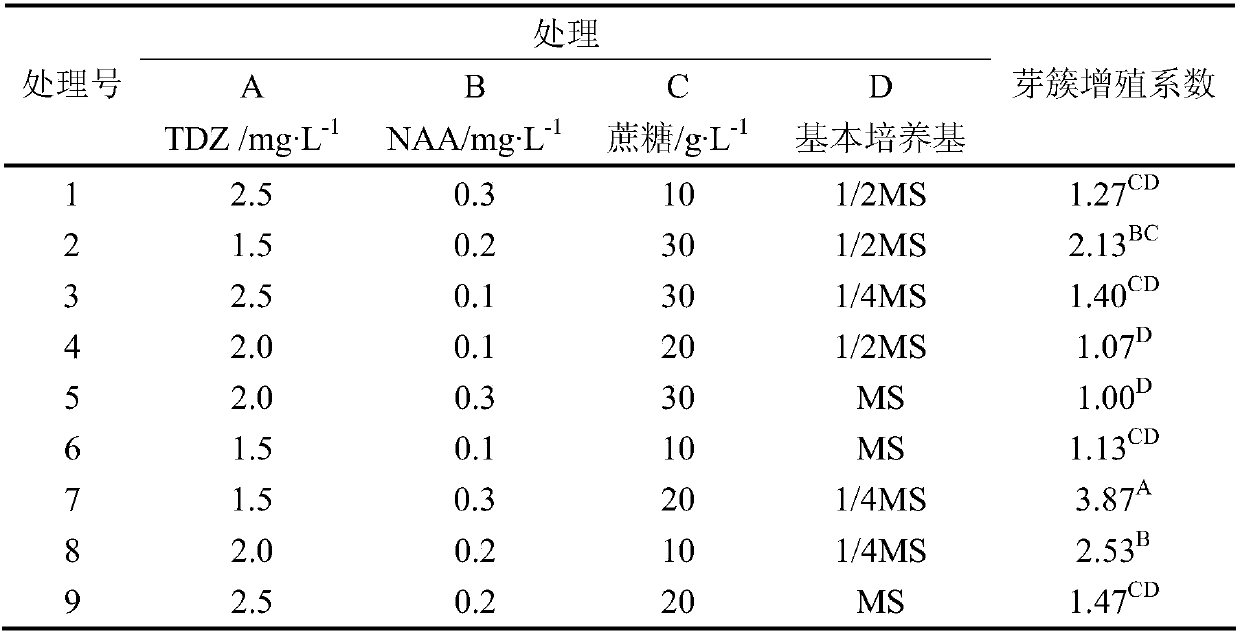A method for inducing protocorm bud cluster proliferation of rhododendron orchid
A technology of protocorm buds and protocorms, which is applied in the field of inducing protocorm cluster proliferation of rhododendron orchids, can solve the problems of low reproduction coefficient, abortion of seed embryos, difficulty in natural germination into seedlings, etc., and achieves the effect of low reproduction coefficient
- Summary
- Abstract
- Description
- Claims
- Application Information
AI Technical Summary
Problems solved by technology
Method used
Image
Examples
Embodiment 1
[0016] Embodiment 1: protocorm proliferation culture
[0017] The plant material Rhododendron orchid [Cremastra appendiculata (D.Don.) Makino] in the present invention is collected from Qiandongnan Prefecture, Guizhou Province. After potting, the seeds are obtained by artificial pollination, and the seeds are aseptically germinated on the culture medium to obtain protocorms.
[0018] Protocorms germinated from seeds were used as explants and inoculated in 1 / 2 MS basic medium + 6-BA 1.0mg·L -1 +IBA1.0mg·L -1 +Activated carbon 0.5g·L -1 + sucrose 30g·L -1 +Agar 5.5g·L -1 cultured on proliferation medium. The culture period was 40 days, and the growth of the protocorms was observed and recorded every 10 days, and the culture temperature was 15°C. After about 15 days of culture, the protocorms changed from white to yellow-green. After 40 days of culture, the protocorms multiplied obviously, forming clusters of protocorms with many white hairs on the surface of the protocorms....
Embodiment 2
[0019] Embodiment 2: Bud cluster induction culture
[0020] Select clustered protocorms with good growth potential in Example 1, inoculate them with different types and concentrations of plant growth regulators, different concentrations of sucrose and different basic medium 1 / 4MS, 1 / 2MS or MS, using TDZ, NAA, Sucrose, basic medium 4 factors 3 levels of orthogonal test, except that the culture temperature is (25 ± 2) ℃, other culture conditions are the same as embodiment 1. After 30 days, the bud cluster induced proliferation coefficient is counted (wherein, the bud cluster proliferation coefficient=inoculation The number of buds after inoculation / the number of buds before inoculation) was used to investigate the effects of different treatments on the formation of bud clusters induced by protocorms. Conclusion: Protocorm induction bud cluster medium is 1 / 4MS+TDZ 1.5mg·L -1 +NAA0.3mg·L -1 + sucrose 20g·L -1 +Agar 5.5g·L -1 The effect is better (Table 1). In this medium, the ...
Embodiment 3
[0024] Embodiment 3: bud cluster proliferation subculture
[0025] The bud cluster induced in Example 2 is divided into two parts, one part is the undifferentiated protocorm in the bud cluster, which is inserted into the bud cluster induction medium in the above-mentioned embodiment 2 to continue the bud cluster induction formation, and after 30 days, no The base of the differentiated protocorm sprouts new shoots, and some of the new shoot leaves start to stretch, which can be re-divided and subcultured; the other part is a protocorm with obviously enlarged pseudobulbs and a tendency to differentiate into seedlings. Rooting medium 1 / 4 MS+6-BA2.0mg·L -1 +NAA 0.1mg·L -1 +Activated carbon 0.5g·L -1 + sucrose 30g·L -1 +Agar 5.5g·L -1 Carry out rooting culture in the middle, after 15d, blade unfolds, and root emerges, grows 3~5 after 30d and is the healthy and strong rhododendron orchid seedling of 2~3cm root, and culture condition is the same as embodiment 2.
PUM
 Login to View More
Login to View More Abstract
Description
Claims
Application Information
 Login to View More
Login to View More - R&D
- Intellectual Property
- Life Sciences
- Materials
- Tech Scout
- Unparalleled Data Quality
- Higher Quality Content
- 60% Fewer Hallucinations
Browse by: Latest US Patents, China's latest patents, Technical Efficacy Thesaurus, Application Domain, Technology Topic, Popular Technical Reports.
© 2025 PatSnap. All rights reserved.Legal|Privacy policy|Modern Slavery Act Transparency Statement|Sitemap|About US| Contact US: help@patsnap.com


